More plumbing, less sewing. Just before I left on an unexpected trip, I reached down to move the bathroom trash can and made a horrible discovery — it weighed a ton. Underneath a snowy layer of tossed kleenices, the trash can was filled, nearly to the brim, with water. Yikes. We had a leak. We had two leaks, actually; one at the faucet, and one in the line.
I turned the shut-off valve to “off” and left town. When I got back, the toilet had stopped working, too. And there’d been a power surge that caused an electrical explosion in the house. Oh, joy.
Mr. Noile called in an electrician while I was gone, so that knocked off the initial electric stuff. The toilet was pretty easy; it fails about every six months, so I’m used to dismantling it. The sink, however, was another matter.
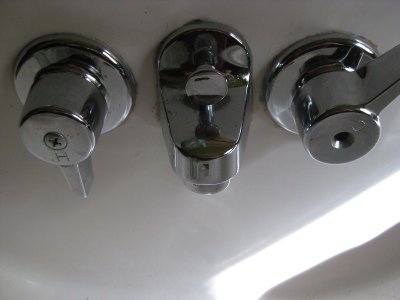 (I’d already removed one screw when I remembered to take a “before” shot.) A plumber was not an option, at least partly because he would undoubtedly tell us that we needed to replace the sink, since we could get both a new sink and a faucet unit for less than I was going to pay for the new faucet unit. If I could find it.
(I’d already removed one screw when I remembered to take a “before” shot.) A plumber was not an option, at least partly because he would undoubtedly tell us that we needed to replace the sink, since we could get both a new sink and a faucet unit for less than I was going to pay for the new faucet unit. If I could find it.
This would have been good advice, except that we have tile on lathe * lath-and-plaster walls. I don’t even want to think about the bill we’d have on our hands once the plumber finished removing the old sink and installing the new one. So it was do-it-yourself time.
Underneath the sink wasn’t too intimidating, but it was a very tight fit. I was pretty bruised and banged up before this job was done, and never was able to imagine how a 200 pound plumber could have fit in the minuscule space between the sink legs and the wall.
Once the faucet handles are removed, you turn those chunky, nautical-looking nuts, and remove the brass nuts on the water lines, and the faucet unit pulls out.
The first challenge, though, was removing the faucet handles. Taking the screws out did nothing; they were frozen in place, probably since the 1970s, when I suspect this set was installed.
I used this nifty tool — a (imagine that!) faucet puller:
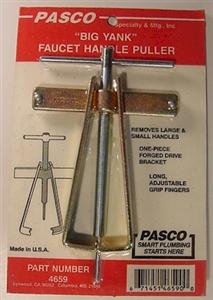 You place the ends behind the faucet handle, and then screw until the handle comes off. Worked a treat for the cold water handle, but then disaster struck. The stem came with the hot water faucet, and broke off. It’s missing in the photo below:
You place the ends behind the faucet handle, and then screw until the handle comes off. Worked a treat for the cold water handle, but then disaster struck. The stem came with the hot water faucet, and broke off. It’s missing in the photo below:
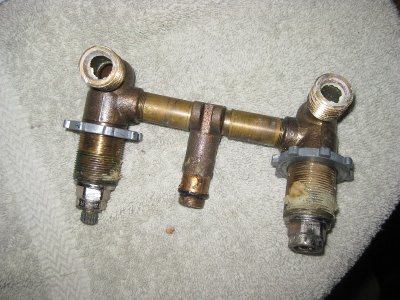 The broken stem is what made replacing the unit essential, as opposed to just replacing washers; can’t do anything without a faucet stem. A trip to three local hardware stores confirmed my worst fears. The sink itself was installed in 1952, and, as it turns out, all modern sinks have faucets that come off the top of the sink, not out the wall of the bowl.
The broken stem is what made replacing the unit essential, as opposed to just replacing washers; can’t do anything without a faucet stem. A trip to three local hardware stores confirmed my worst fears. The sink itself was installed in 1952, and, as it turns out, all modern sinks have faucets that come off the top of the sink, not out the wall of the bowl.
Fortunately, there’s a plumbing supply place in a nearby town, so I headed there the next morning. The guy behind the counter was shaking his head as soon as I unwrapped the unit, but he said he’d look upstairs and see what he could find. When he returned he was carrying box labeled “ledgeback lavatory faucet” made by Union Brass of Eagan, Minnesota. (Let’s hear it for the heartland, eh?) I happily left the equivalent of my right arm in cash at the counter and returned to this:
 That’s plumber’s putty; it goes under the faucet facings. Porcelain scratches, so I used a nylon scraper to remove this yucky stuff. By the way, don’t ever put anything metal in your porcelain sink unless you’ve lined the sink with a towel first. That spout should not be sitting directly on the porcelain.
That’s plumber’s putty; it goes under the faucet facings. Porcelain scratches, so I used a nylon scraper to remove this yucky stuff. By the way, don’t ever put anything metal in your porcelain sink unless you’ve lined the sink with a towel first. That spout should not be sitting directly on the porcelain.
I thought removing the putty would be tricky, but it was pretty soft, and came off easily, yielding the result below:
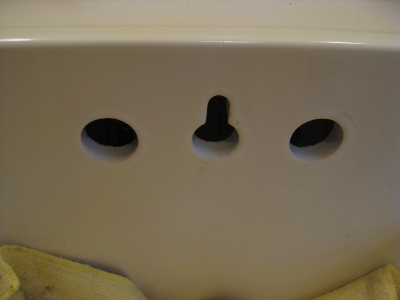 The next step was truly scary. The faucet unit is sold as as adjustable one — and was far too wide for my sink. I had to lop off an inch or so of copper pipe from each end. Weirdly, while at IKEA a while ago, I’d picked up a pipe cutter, thinking that I might use it for jewelry (or, just possibly, because it was very cheap and looked like a cool toy). After measuring three times, and then double-checking my work, I marked and cut the pipes:
The next step was truly scary. The faucet unit is sold as as adjustable one — and was far too wide for my sink. I had to lop off an inch or so of copper pipe from each end. Weirdly, while at IKEA a while ago, I’d picked up a pipe cutter, thinking that I might use it for jewelry (or, just possibly, because it was very cheap and looked like a cool toy). After measuring three times, and then double-checking my work, I marked and cut the pipes:
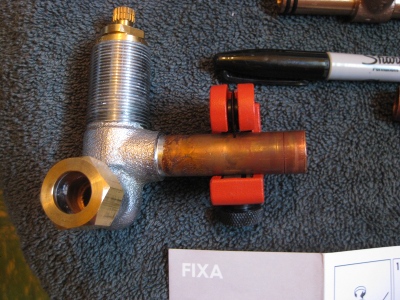 This was particularly nerve-wracking because the original unit was not cut perfectly to the center stem; when fit properly to the sink, the copper tubing didn’t meet the center unilaterally, so it wasn’t as if I could just cut them to match. As you can see below, the new unit looks too big compared to the old. It’s not; in this picture, the old just isn’t pulled out to fit the sink.
This was particularly nerve-wracking because the original unit was not cut perfectly to the center stem; when fit properly to the sink, the copper tubing didn’t meet the center unilaterally, so it wasn’t as if I could just cut them to match. As you can see below, the new unit looks too big compared to the old. It’s not; in this picture, the old just isn’t pulled out to fit the sink.
 The helpful guy at the plumbing supply place warned me that there were o-rings inside the fixture that could be sheared and rendered useless if I left any kind of burr or sharp edge inside the copper pipe. Fine sandpaper worked to make sure that the inside was smooth. (I tested it with a finger and wasn’t wounded; I figured that was good enough.) However, he didn’t mention that cutting copper pipe distorts it.
The helpful guy at the plumbing supply place warned me that there were o-rings inside the fixture that could be sheared and rendered useless if I left any kind of burr or sharp edge inside the copper pipe. Fine sandpaper worked to make sure that the inside was smooth. (I tested it with a finger and wasn’t wounded; I figured that was good enough.) However, he didn’t mention that cutting copper pipe distorts it.
Copper is so soft that this is apparently unavoidable. However, the very minor distortion meant that I could not insert the brass pipe (the one to which the o-rings were attached) into the copper without shearing the o-rings. (Ask me how I know.) I headed off to our local independent hardware store and asked for advice.
It turns out that a full-sized pipe cutter comes with a little triangular gadget that is used to ream the pipe once it’s cut. It molds the pipe back into the correct shape, and removes the ridge cutting it leaves. This is apparently not a concern for IKEA, who are not notable for selling copper components. Lesson learned.
Here’s the unit, set in place for a fitting. The picture’s taken at a slight angle, and the fixture is resting on the bottom of the openings. For final installation, it set higher, and was centered properly. And it fit! (Note the towel in the sink. Better to be smart eventually than never.)
Installing it requires screwing the spout and the decorative flanges onto the front side (after filling them with plumber’s putty). Then you crawl back under the sink for the hundredth time and re-attach the nautical-looking nuts, very, very gently so that you don’t crack the porcelain. In order to seat the unit correctly, I had to fiddle a little bit with the tensions from front to back; like a lot of porcelain sinks, ours isn’t perfectly even. Here’s the final result:
I originally thought I’d installed this unit upside down. The famous torque adage is “lefty, loosey, righty, tighty” but in this case you turn the faucets to the right to open them, and to the left to close them. I went to bed on installation night cursing myself for the amateur that I am, but in the morning learned that there is only one way to install this unit, and that’s how I’d done it.
After all this, though, I still had a leak. All I’d really done is the equivalent of replacing the washers that had worn out and caused a slow leak from the faucets. The leak that had filled the wastebasket was coming from a water line. I had hoped that removing the line and reseating it would fix the problem, but it didn’t.
I wasn’t too sorry, though, since this meant that I could replace the old inflexible water lines with flexible ones. Six bucks (and yet another trip to the hardware store) later, I had them in hand. One last sojourn under the sink, bolts detached and tightened once again, and the job was done.
I couldn’t get flexible pipe in the size I theoretically needed, but the next size up worked fine, since moderate flexing in no way interferes with the transfer of water.
When I was done, I did the most important thing of all:
Yep — put a roasting pan under the whole thing for 48 hours. You can’t be too sure. And after that, I replaced the wastebasket, putting it in the exact same spot. I’m a huge fan of having waterproof wastebaskets under plumbing. This isn’t the first time I’ve found a leak this way, though it’s the first time in this house. And the first time the leak has gone undetected for so long due to rising kleenices –that was an artful touch!
*We do not have a lathe in our walls Chez Noile. Nor, it seems, do we have an adequate editor. However, Noile has an excellent cousin who unfailingly catches these things, and, in doing so, makes Noile a happier person. Merci, Fair Cuz!
Related: The Kitchen Sink


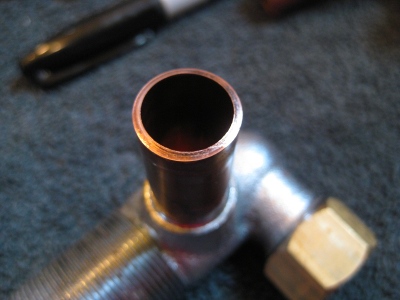

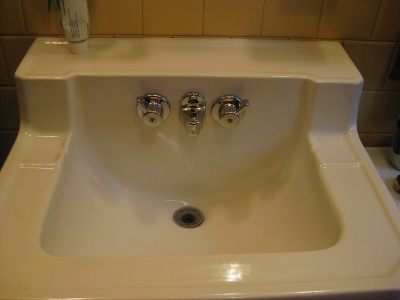
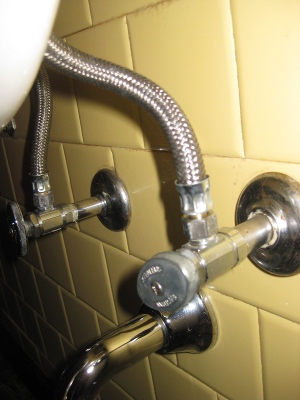
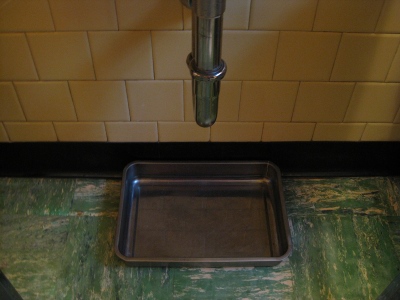
Even plumbing is interesting when you write about it and there´s so much to learn – not “only” how to DIY, but vocabulary like “kleenices”. Will I find this plural in my Websters or is it your Latin-lovers invention?
Ah, prachtstueckwerk, now you know what I’ve been doing instead of “visiting” with you! I am afraid your suspicions regarding my vocabulary are correct: Mr. Webster would NOT approve!
“Kleenices”! I love it! Thanks for the plumbing tutorial. In my experience, simple plumbing tasks are either easy or impossible, but you can’t tell which until it is too late to turn back.
Heh. KC, my rule for undertaking plumbing is simple: If the situation is so bad that it’s got to be addressed, I figure there’s little risk in tackling it, since failure only means that I end up where I started — needing to call the plumber!
So far, this rule has served me well, but I do admit to having been cautious in applying it. At $200/hour for the plumber (that is NOT a typo!), it’s worth even days of DIY — as long as I don’t break anything.
I am highly impressed. I am moderately DIY competent–I changed a faulty switch on my garbage disposal and braced some poorly constructed drawers–but you will never catch me near plumbing unless I’m using it!
I’m impressed, Trena! I do switches, too, but they scare me to death, and I have Mr. Noile shut off the mains, since I’m very absent-minded, and would rather not risk electrocution. And drawers? Not an easy fix at all — although I can see that not having to deal with water would be an attraction!
Oh. My. Goodness.
You are a better woman than I.
I hope you can do some sewing soon. 🙂
Shams said
“You are a better woman than I.”
That seems most unlikely! Not to mention that one of my cherished aspirations is to sew as interesting an oeuvre as yours. Plumbing will NOT get me there!